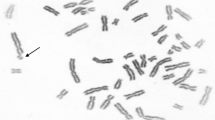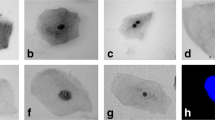Abstract
We investigated the micronucleus frequencies in peripheral blood lymphocytes of 225 mastic asphalt workers (age 17–62 years) and 69 non-bitumen-exposed road construction workers (age 18–64 years) in Germany before and after the working shift. Median shift exposure to vapours and aerosols of bitumen of exposed workers was 3.0 mg/m³. Micronuclei (MN) were determined with a standard method using cytochalasin B. Median MN frequency was 6.0 (interquartile range (IQR) 4.0–8.5) MN/1,000 binucleated lymphocytes (MN/1,000 BNC) in exposed workers and 6.0 (IQR 4.0–8.3) MN/1,000 BNC in non-exposed workers before shift. After shift, we observed 6.5 (IQR 4.4–9.3) MN/1,000 BNC in exposed workers and 6.5 (IQR 4.0–9.0) MN/1,000 BNC in non-exposed workers. Regression models were applied with the log-transformed MN frequency as the dependent variable in order to estimate the effects of exposure to vapours and aerosols of bitumen and of potential confounders. Age was the strongest predictor of MN formation in both exposed workers and referents. Our data suggest that MN formation was not associated with concentration of vapours and aerosols of bitumen during shift at the individual level. Although similar MN frequencies were observed in both groups, the modelling of factors potentially influencing MN frequency revealed a weak group difference in the post-shift model. We conclude that this small difference cannot be judged to be a relevant mutagenic effect of exposure to vapours and aerosols of bitumen, also with regard to the lack of adjustment for multiple testing and the lack of a group effect in the original data.
Similar content being viewed by others
References
Bolognesi C, Abbondandolo A, Barale R, Casalone R, Dalpra L, De Ferrari M, Degrassi F, Forni A, Lamberti L, Lando C, Migliore L, Padovani P, Pasquini R, Puntoni R, Sbrana I, Stella M, Bonassi S (1997) Age-related increase of baseline frequencies of sister chromatid exchanges, chromosome aberrations, and micronuclei in human lymphocytes. Cancer Epidemiol Biomarkers Prev 6:249–256
Bonassi S, Fenech M, Lando C, Lin YP, Ceppi M, Chang WP, Holland N, Kirsch-Volders M, Zeiger E, Ban S, Barale R, Bigatti MP, Bolognesi C, Jia C, Di Giorgio M, Ferguson LR, Fucic A, Lima OG, Hrelia P, Krishnaja AP, Lee TK, Migliore L, Mikhalevich L, Mirkova E, Mosesso P, Müller WU, Odagiri Y, Scarffi MR, Szabova E, Vorobtsova I, Vral A, Zijno A (2001) HUman MicroNucleus project: international database comparison for results with the cytokinesis-block micronucleus assay in human lymphocytes: I. effect of laboratory protocol, scoring criteria, and host factors on the frequency of micronuclei. Environ Mol Mutagen 37:31–45
Bonassi S, Neri M, Lando C, Ceppi M, Lin YP, Chang WP, Holland N, Kirsch-Volders M, Zeiger E, Fenech M (2003) Effect of smoking habit on the frequency of micronuclei in human lymphocytes: results from the human micronucleus project. Mutat Res 543:155–166
Breuer D (2008a) Bitumen (Dämpfe und Aerosole, Bitumen-Kondensatstandard) 6305/2. BGIA-Arbeitsmappe Messung von Gefahrstoffen. Expositionsermittlung bei chemischen und biologischen Einwirkungen. 40. Lieferung. Erich Schmidt, Berlin
Breuer D (2008b) Bitumen (Dämpfe und Aerosole, Mineralölstandard) 6305/1. BGIA-Arbeitsmappe Messung von Gefahrstoffen. Expositionsermittlung bei chemischen und biologischen Einwirkungen. 40. Lieferung. Erich Schmidt, Berlin
Breuer D, Hahn J-U, Höber D, Emmel C, Musanke U, Rühl R, Spickenheuer A, Raulf-Heimsoth M, Bramer R, Seidel A, Schilling B, Heinze E, Kendzia B, Marczynski B, Welge P, Angerer J, Brüning T, Pesch B (2011) Air sampling and determination of vapours and aerosols of bitumen and polycyclic aromatic hydrocarbons in the Human Bitumen Study. Arch Toxicol. doi:10.1007/s00204-011-0678-1
Burgaz S, Erdem O, Karahalil B, Karakaya AE (1998) Cytogenetic biomonitoring of workers exposed to bitumen fumes. Mutat Res 419:123–130
Fenech M (2000) The in vitro micronucleus technique. Mutat Res 455:81–95
Fenech M (2007) Cytokinesis-block micronucleus cytome assay. Nat Protoc 2:1084–1104
Fuhst R, Creutzenberg O, Ernst H, Hansen T, Pohlmann G, Preiss A, Rittinghausen S (2007) Twenty-four months inhalation carcinogenicity study of bitumen fumes in wistar (WU) rats. J Occup Environ Hyg 4(suppl 1):20–43
IARC (2010) Some non-heterocyclic polycyclic aromatic hydrocarbons and some related exposures. IARC monographs on the evaluation of carcinogenic risks to humans. International Agency for Research on Cancer, Lyon
Järvholm B, Nordström G, Högstedt B, Levin JO, Wahlström J, Ostman C, Bergendahl C (1999) Exposure to polycyclic aromatic hydrocarbons and genotoxic effects on nonsmoking Swedish road pavement workers. Scand J Work Environ Health 25:131–136
Karaman A, Pirim I (2009) Exposure to bitumen fumes and genotoxic effects on Turkish asphalt workers. Clin Toxicol (Phila) 47:321–326
Murray EB, Edwards JW (2005) Differential induction of micronuclei in peripheral lymphocytes and exfoliated urothelial cells of workers exposed to 4,4′-methylenebis-(2-chloroaniline) (MOCA) and bitumen fumes. Rev Environ Health 20:163–176
NIOSH (2000) Hazard review: health effects of occupational exposure to asphalt. DHHS (NIOSH) publication no. 2001–110
Raulf-Heimsoth M, Pesch B, Rühl R, Brüning T (2011) The human bitumen study: executive summary. Arch Toxicol. doi:10.1007/s00204-011-0679-0
Rothman KJ (1998) Writing for epidemiology. Epidemiology 9:333–337
Rühl R, Musanke U, Kolmsee K, Prieß R, Zoubek G, Breuer D (2006) Vapours and aerosols of bitumen: exposure data obtained by the German bitumen forum. Ann Occup Hyg 50:459–468
Schreiner CA (2010) Review of mechanistic studies relevant to the potential carcinogenicity of asphalts. Regul Toxicol Pharmacol. doi:10.1016/j.yrtph.2010.10.010
Schulte PA (2007) Gaps in scientific knowledge about the carcinogenic potential of asphalt/bitumen fumes. J Occup Environ Hyg 4(Suppl 1):3–5
Sivak A, Niemeier R, Lynch D, Beltis K, Simon S, Salomon R, Latta R, Belinky B, Menzies K, Lunsford A, Cooper C, Ross A, Bruner R (1997) Skin carcinogenicity of condensed asphalt roofing fumes and their fractions following dermal application to mice. Cancer Lett 117:113–123
van Gooswilligen G (2000) Bitumen. In: Lucas AG (ed) Modern petroleum technology, vol 2. Wiley, Chichester, pp 407–430
WHO (2004) Asphalt (Bitumen). Concise international chemical assessment document 59. World Health Organization, Geneva
Acknowledgments
The Human Bitumen Study was initiated by the German Committee for Hazardous Substances (AGS) and the German Bitumen Forum and financially supported by: German Social Accident Insurance (DGUV), Eurobitume, Deutscher Asphaltverband e.V., Concawe, Zentralverband des Deutschen Dachdeckerhandwerks, Industrieverband Bitumen-, Dach- und Dichtungsbahnen e.V., Berufsgenossenschaft Rohstoffe und Chemische Industrie (BG RCI) and Aksys GmbH, Beratungsstelle Gussasphaltanwendungen (bga), BG BAU, Arbeitsgemeinschaft der Bitumenindustrie (Arbit). We thank all workers having participated in the Human Bitumen Study. We gratefully acknowledge the support of the field team especially Anne Flagge, Anja Molkenthin, Bianca Wachter, Dieter Höber, Gerd Zoubek, and in parts of the study Klaus Schott (†) and Hans-Jürgen Schicker and the team in the laboratory especially Anja Erkes for their skilful technical assistance.
Author information
Authors and Affiliations
Corresponding author
Rights and permissions
About this article
Cite this article
Welge, P., Marczynski, B., Raulf-Heimsoth, M. et al. Assessment of micronuclei in lymphocytes from workers exposed to vapours and aerosols of bitumen. Arch Toxicol 85 (Suppl 1), 65–71 (2011). https://doi.org/10.1007/s00204-011-0683-4
Received:
Accepted:
Published:
Issue Date:
DOI: https://doi.org/10.1007/s00204-011-0683-4




